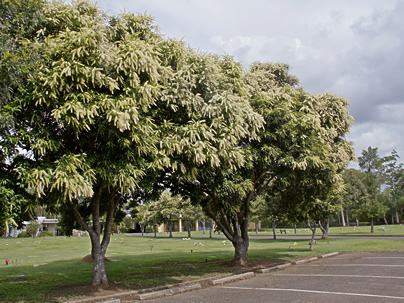The Ivory Curl Tree (Buckinghamia celsissima) is an evergreen, floriferous, and highly ornamental tree native to the tropical forests of northern Queensland, Australia. It reaches medium to large sizes, attaining about 98 feet (30 meters) in height in its natural habitat. However, in cultivation, it rarely exceeds 26 feet (8 meters). It has a rounded canopy with a diameter of 6.5 to 16.4 feet (2 to 5 meters) and an elegant trunk with brown to gray bark.
It features elliptical, entire leaves with a well-defined central vein and dark green, shiny upper surfaces, while the lower surface is whitish with a velvety texture. It blooms in the summer, producing long and cylindrical inflorescences, in a raceme-like arrangement, hanging down from the terminals, with cream-colored flowers and curved stamens. The resulting fruits are woody follicles with a brown color.

In landscaping, the Ivory Curl Tree is a highly appealing option due to its durability, low maintenance requirements, and extraordinary beauty during flowering. Because of its restricted growth in cultivation, it is ideal for planting along walkways and other urban areas.
The Ivory Curl Tree can be used as a standalone specimen, in rows, or in small groups. It is highly attractive to insects during flowering and provides pleasant shade throughout the year. Although still rare in cultivation in Brazil, it is showing good adaptation to our climate and soils.
It should be grown in full sun, in well-draining soil enriched with organic matter, and regularly irrigated during the first year of establishment. It does not tolerate waterlogged soils but is quite water-demanding. Therefore, it may not be suitable for areas with irregularly distributed rainfall and long dry periods.
The Ivory Curl Tree can tolerate partial shade. It does not withstand strong frosts, especially when young, but once well-established, it can tolerate occasional frosts. Cold and water scarcity will slow down the plant’s growth, possibly preventing it from reaching tree size. This species does not require pruning, but it can be pruned without issues by those who wish to shape it in a specific way. It can be propagated by seeds but mainly through semi-hardwood stem cuttings. The flowering of Buckinghamia celsissima typically begins around 3 to 5 years after planting.


